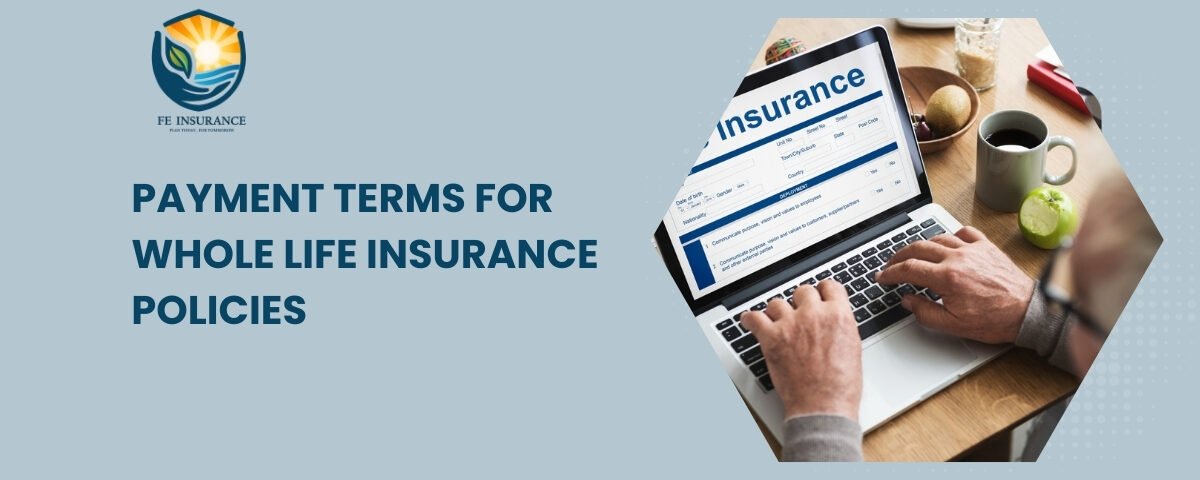Payment Terms for Whole Life Insurance Policies: Everything You Need to Know

Understanding Riders in Final Expense Insurance Policies
September 8, 2025
How Much Does Home Insurance Cost in 2025?
September 23, 2025When exploring life insurance, many people wonder about the payment terms for whole life insurance policies. Unlike term life insurance, which expires after a set number of years, whole life insurance offers lifelong protection as long as premiums are paid.
But how do the payment terms work? Can you pay off a policy early? And what happens to the value of your premiums over time? This article dives deep into these questions, covering everything from premium structures to policy maturity and dividend options.
What Are Payment Terms in Whole Life Insurance?
Payment terms refer to how and when you pay premiums to keep your policy active. With whole life insurance, payments are typically structured to provide lifelong coverage. Unlike term policies, which may leave people wondering what happens at the end of a term life insurance plan, whole life coverage does not expire as long as premiums are met.
Common payment structures include:
- Straight Life Policy – Payments continue for the insured’s entire life. This is the most common form of whole life insurance.
- Limited-Pay Life Policy – Premiums are only required for a fixed number of years (such as 10, 20, or 30), but coverage continues for life.
- Single-Premium Policy – A lump-sum payment made at the start funds the entire policy.
Straight Life vs. Limited-Pay Life: Key Differences
Many people ask, What is a straight life policy compared to a limited-pay option. Here’s the breakdown:
- Straight Life: You pay consistent premiums throughout your lifetime.
- Limited-Pay Life: You pay higher premiums for a limited period, after which the policy is fully funded.
For example, a limited-pay life policy has the advantage of freeing you from future payments in retirement, while still ensuring lifetime coverage. On the other hand, a straight life may be more affordable annually since payments are spread out for life.
At What Point Does a Whole Life Insurance Policy Endow?
A common question is, at what point does a whole life insurance policy endow? Endowment occurs when the policy’s cash value equals the death benefit, often at age 100 or 121, depending on the insurer. At this point, the insured typically receives the full face value, even if they’re still alive.
To put it simply, what does endow mean in life insurance? It means the policy has fully matured, and the cash value matches the policy’s payout.
Can You Pay Off a Whole Life Insurance Policy Early?
Yes, in many cases you can. Policyholders often ask, Can you pay off a whole life insurance policy early? With a limited-pay or single-premium option, you can complete payments well before the end of life, securing lifelong coverage without the burden of ongoing premiums. However, paying early requires careful financial planning since the upfront costs are higher.
What Happens to the Total Amount of Premium Paid?
One of the biggest advantages of whole life insurance is that it builds cash value. Many wonder what happens to the total amount of premium paid? Over time:
- Part of your payment covers insurance costs.
- The remainder goes toward building cash value.
- This cash value grows tax-deferred and can be borrowed against.
This makes whole life policies attractive to people interested in what is accumulation value in life insurance is, as it provides both protection and a financial asset.
Participating vs. Non-Participating Whole Life Policies
Whole life policies can be participating or non-participating:
- Participating: These policies may pay dividends. A whole life insurance policy that pays dividends allows you to reinvest, reduce premiums, or take payouts in cash.
- Non-Participating: These policies don’t pay dividends, but typically have lower premiums.
Understanding this difference helps you evaluate long-term value beyond just payment terms.
Lincoln Heritage and Policy Legitimacy
Many people search for specific providers, such as Lincoln Heritage, and ask: is Lincoln Heritage Life Insurance Company legitimate? Yes, it is a licensed insurer in the U.S., offering final expense insurance products. For Spanish-speaking clients, Lincoln Heritage Life Insurance en Español provides accessible customer support.
If you’re a policyholder needing help, you can reach Lincoln Heritage Life Insurance customer service by phone through their official website.
What Happens at the End of a Term Life Policy vs. Whole Life?
It’s helpful to compare with term insurance. What happens at the end of a term life policy? Coverage ends, and you don’t receive your premiums back (unless you purchased a return-of-premium rider).
With whole life coverage never expires as long as premiums are paid, and the growing cash value ensures you’re building wealth alongside protection.
FAQs
1. What are the typical payment terms for whole life insurance policies?
Most policies require either lifetime payments (straight life), fixed-term payments (limited-pay), or a single lump-sum premium. Each has unique advantages depending on your budget and goals.
2. At what point does a whole life insurance policy endow?
A policy ends when its cash value equals the death benefit, often around age 100–121. At this point, the insurer pays the policyholder the full value.
3. Can you pay off a whole life insurance policy early?
Yes, through limited-pay or single-premium policies. This allows you to secure lifelong coverage without paying premiums into retirement.
4. What is the accumulation value in life insurance?
It refers to the cash value built over time. This amount grows tax-deferred and can be borrowed against, withdrawn, or left to grow until policy maturity.
5. What happens to the total amount of premium paid in whole life insurance?
Part of the premiums covers the insurance cost, while the rest funds the policy’s cash value. This makes whole life insurance both a protection plan and a savings vehicle.
Conclusion:
When evaluating payment terms for whole life insurance policies, the choice comes down to financial planning. Straight life policies spread payments over your lifetime, while limited-pay or single-premium options allow you to complete payments early. Policies that pay dividends or accumulate cash value provide an additional layer of long-term benefits.
Whether you’re comparing participating vs. non-participating insurance, looking into policy endowment, or wondering how whole life differs from term life, the key is understanding how premiums and benefits align with your long-term goals.




